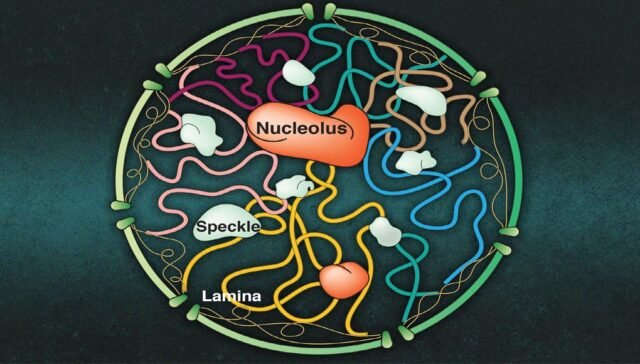The nucleus, a defining feature of eukaryotic cells, is often referred to as the “control center” of the cell. Encased within a double membrane, it houses the genetic material – DNA – and orchestrates processes critical to life, such as DNA replication, transcription, and gene regulation. This study material delves into the intricate structure and functions of the nucleus, emphasizing its role in DNA storage and gene regulation, fundamental processes for cellular growth, development, and homeostasis.
1. Structure of the Nucleus
1.1 The Nuclear Envelope
The nuclear envelope is a double membrane structure that separates the contents of the nucleus from the cytoplasm. It consists of:
- Inner membrane: Closely associated with the nucleoplasm and chromatin.
- Outer membrane: Continuous with the endoplasmic reticulum, supporting protein synthesis.
- Perinuclear space: The gap between the two membranes, facilitating molecular transport.
- Nuclear pores: Large protein complexes that regulate bidirectional transport of RNA, proteins, and ions, maintaining cellular homeostasis.
1.2 The Nucleoplasm
The nucleoplasm, also known as nuclear sap, is a gel-like substance containing ions, molecules, and enzymes essential for DNA and RNA metabolism. It provides a medium for molecular diffusion and structural support for nuclear components.
1.3 The Nucleolus
The nucleolus is a prominent, dense region within the nucleus, primarily involved in ribosomal RNA (rRNA) synthesis and ribosome assembly. It plays a pivotal role in protein synthesis by producing ribosomal subunits that are exported to the cytoplasm.
1.4 The Nuclear Matrix
The nuclear matrix is a fibrous network that provides structural support and organizes chromatin. It aids in spatial arrangement, ensuring efficient transcriptional regulation and replication.
2. DNA Organization in the Nucleus
2.1 Chromatin Structure
DNA in the nucleus is packaged into chromatin, a complex of DNA and proteins. Chromatin exists in two forms:
- Euchromatin: Loosely packed, transcriptionally active regions.
- Heterochromatin: Densely packed, transcriptionally inactive regions, often associated with structural roles.
2.2 Nucleosomes
The nucleosome is the fundamental unit of chromatin. It consists of DNA wrapped around histone proteins (H2A, H2B, H3, and H4). This structure facilitates DNA compaction and regulation by controlling access to genetic material.
2.3 Higher-Order Chromatin Organization
Chromatin undergoes multiple levels of organization:
- Nucleosome formation: DNA wraps around histones.
- 30-nm fiber: Nucleosomes fold into a solenoid structure.
- Looped domains: Fibers loop and attach to the nuclear matrix.
- Chromosome formation: During mitosis, chromatin condenses into visible chromosomes.
2.4 Telomeres and Centromeres
- Telomeres: Repetitive sequences at chromosome ends, protecting them from degradation and fusion.
- Centromeres: Central regions that ensure proper chromosome segregation during cell division.
3. DNA Storage and Maintenance
3.1 DNA Replication
DNA replication ensures genetic material is accurately duplicated before cell division. Key steps include:
- Initiation: Helicase unwinds DNA; primase synthesizes primers.
- Elongation: DNA polymerase adds complementary nucleotides to the template strand.
- Termination: Ligase seals Okazaki fragments, completing replication.
3.2 DNA Repair Mechanisms
To maintain genomic integrity, the nucleus employs several repair mechanisms:
- Base excision repair: Fixes single-base lesions.
- Nucleotide excision repair: Removes bulky DNA damage.
- Mismatch repair: Corrects replication errors.
- Homologous recombination: Repairs double-strand breaks using a homologous sequence.
4. Gene Regulation in the Nucleus
4.1 Transcriptional Regulation
Transcription is the process of synthesizing RNA from DNA. Regulation occurs at multiple levels:
- Promoters: DNA sequences where RNA polymerase binds to initiate transcription.
- Enhancers and silencers: Elements that increase or repress transcription efficiency.
- Transcription factors: Proteins that bind to specific DNA sequences to activate or inhibit transcription.
4.2 Epigenetic Regulation
Epigenetics involves heritable changes in gene expression without altering DNA sequences. Mechanisms include:
- DNA methylation: Addition of methyl groups to cytosine, silencing genes.
- Histone modifications: Acetylation, methylation, and phosphorylation affecting chromatin accessibility.
- Chromatin remodeling: ATP-dependent processes repositioning nucleosomes to regulate access.
4.3 Post-Transcriptional Regulation
Gene expression is further regulated after transcription:
- Alternative splicing: Generates multiple mRNA variants from a single gene.
- RNA editing: Alters nucleotide sequences in RNA.
- MicroRNAs (miRNAs): Small RNAs that bind to mRNA, inhibiting translation or promoting degradation.
5. RNA Processing and Translation
5.1 Pre-mRNA Modifications
Before translation, eukaryotic mRNA undergoes several modifications:
- 5′ capping: Addition of a modified guanine nucleotide for stability and ribosome binding.
- Polyadenylation: Addition of a poly-A tail to the 3′ end for stability and nuclear export.
- Splicing: Removal of introns and joining of exons to form mature mRNA.
5.2 Translation Process
Translation converts mRNA into proteins through:
- Initiation: Small ribosomal subunit binds to mRNA; tRNA pairs with the start codon.
- Elongation: Ribosome moves along mRNA, synthesizing a polypeptide chain.
- Termination: Ribosome encounters a stop codon, releasing the completed protein.
6. Advanced Topics in Gene Regulation
6.1 Operons in Prokaryotes
Operons are gene clusters transcribed together, regulated by repressors and activators. For example, the lac operon in E. coli is activated in the presence of lactose and repressed when glucose is available.
6.2 Chromatin Remodeling Complexes
ATP-dependent chromatin remodeling complexes, such as SWI/SNF, alter nucleosome positioning to regulate DNA accessibility for transcription, replication, and repair.
6.3 Proteasome-Mediated Regulation
Proteasomes degrade ubiquitin-tagged proteins, regulating cellular processes like the cell cycle, apoptosis, and stress responses.
Conclusion
The nucleus is indispensable for cellular function, acting as the repository for genetic information and the hub for gene regulation. Through its intricate structure and multifaceted mechanisms, it ensures the fidelity of DNA storage, the precision of gene expression, and the stability of cellular operations. Understanding the nucleus not only unravels the complexities of life at the molecular level but also provides insights into addressing genetic disorders and advancing therapeutic strategies.












